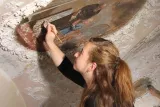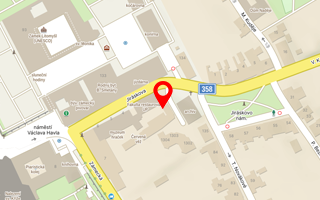Established in Litomyšl in 1993, comprehensive wall painting restoration training corresponds with the curricula and education system which has been practised at prestigious universities in Europe for decades. In our opinion, conservation techniques can be more purposefully divided according to the surface type of the object conserved (plaster, wood, canvas), rather than the art category (painting, sculpture), for each surface type requires an entirely different technical and technological approach. As wall painting as a discipline has historically covered numerous forms and technologies, it is the aim of the Studio to prepare conservators capable of embracing the discipline in its complexity. Apart from wall painting, students are acquainted with the conservation of sgraffito and other plaster techniques.
Similar to other studios at the Faculty of Restoration, the Studio of conservation and restoration of Wall Painting and Sgraffito closely cooperates with other universities, research institutions and individual restoration and conservation specialists across Europe. Each year, students experience internships abroad, where they can gain insight into the most widely discussed issues at present as well as obtain experience outside of the faculty environment.
In the Bachelor course the students get systematically acquainted with artistic and technical aspects of wall painting, all of which graduates must have a profound understanding, as each wall painting technique requires a different approach and procedure. Beginning the third year of study, the core of the study moves to practical conservation carried out on historical objects, although practical assignments are an integral part of the curriculum from the first year of study in the form of mandatory summer practices. The highlight of conservation training is working on the Bachelor’s Thesis in the last year of study. Graduates are prepared to be able to use the acquired knowledge and skills and carry out an independent and qualified survey and assessment of the nature and status of the historical monument in question. On the basis of their assessment, graduates are able to determine the most efficient and relevant conservation intervention from the viewpoint of both technology, history and art, while taking into consideration the restored object‘s general purpose, context and value. Subsequently, they are able to perform a qualified conservation treatment itself.
In the following Master course Conservation and Restoration of Wall Painting, Sculpture Works and Architecture Surfaces, the students refine their practical skills, gain more profound knowledge and a broader overview on restoration and conservation issues also from the perspective of related disciplines. The practical part of study aims to extend the students‘ knowledge not only of wall painting conservation, but also of sculpture and architecture surfaces. Students are encouraged to be independent in their judgement, and to think creatively, both of which they demonstrate in their Master’s Thesis, which is a proof that the student is capable not only of performing the conservation itself, but also to contribute to further development and cultivation of the discipline.





